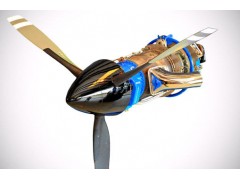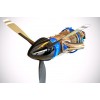This is not to be used as a check list. This is only to be used as a guide to start the GE-Walter M601 B, D & E Turbines.
AUTO START. (Limiter)
1. Power on.
2. Inverter on if necessary.
3. Fuel on.
4. Fuel pump / pumps on.
5. Condition lever forward to detent.
6. Propeller in feather position.
7. Throttle in idle position.
8. Press start. Best to keep hand on condition lever in case of overtemp.
9. Carefully monitor the ITT for increasing temp, do not exceed 710. Rate of increase is important. If over temp occurs, pull condition lever to shut off position.
10. Make sure N1 (Compressor rpm) increases to at least 60%. If not, forward throttle slightly and monitor ITT.
11. After N1 and ITT stabilize, switch on generator.
12. Check oil and fuel pressure.
13. Forward prop to full fine pitch.
AUTOSTART WITH PUSH BUTTON (EHT)
1. Fuel On
2. Power on.
3. Fuel pump on.
4. Throttle to Idle.
5. Prop to Feather.
6. Condition Lever to Run position.
7. Press Start, keeping a hand on the fuel condition lever, and be ready to cut the fuel in case of over temp.
8. As the turbine lights, press the EHT button + - two seconds and carefully monitor the ITT. When the ITT slows down or tends to stabilize, release the button to increase the ITT and N1. Repeat this by keeping the ITT between 580 oC and 650 oC. The further into the start, the more abrupt and sensitive the EHT will become.
9. Make sure N1 (Compressor RPM) increases to at least 60%. If not, advance the throttle slightly and monitor the ITT.
10. After N1 and ITT have stabilized, switch the generator on.
11. Check oil and fuel pressure.
12. Advance the Prop to full fine.
Recommended Practices
It is good practice to start the turbine with headsets off. A possible over temp can be heard quicker than the ITT gauge can display it.
CAUTION
Keep one hand on the Condition Lever and be ready to cut as the button will not prevent an over temp if the throttle is partly open, the batteries are low, or there is high outside temperature and / or elevation. If there is a high turbine temperature (over 150 癈) before starting, a wind from the rear, a blockage of the air intakes, or the ISOL valve is in the ISOL mode, these may also cause an over temp.
important Notice
If the ITT exceeds 735 oC and no more than 800 oC, the turbine must be inspected for damage. (Borescope)
If ITT exceeds 800 oC, the turbine must be dismantled for inspection and a possible change of all compressor turbine blades.
To continue operation after an over temp could cause a catastrophic failure!
Cold Cycle (motor)
1. Master switch on
2. Fuel on
3. Fuel pump ON
4. Throttle to idle
5. Prop to Feather
6. Condition lever in shut off position
7. Turn the Motor switch on and carefully monitor the 20-second Motor sequence.
NOTE
If aircraft batteries are used during the Cold Cycle without a GPU, it is possible to worsen the problem by depleting the batteries.
It is possible to cold cycle the turbine for five to eight seconds and abort by switching the Master off. This will save the battery power and should reduce the turbine temperature enough for a successful start.
IF THE TURBINE TENDS TO OVER TEMP DURING START, THE PROBLEMS COULD BE:
1. Batteries insufficient power.
2. Limiter not working (electrical).
3. Throttle linkage adjustment incorrect, FCU lever has to be on "0" degree.
4. Adjustment on FCU.
5. High elevation.
6. High outside temp.
7. Strong wind from rear of aircraft. Turn into wind.
8. If ITT is 150 癈 and over, cold cycle turbine to cool off before attempting a start.
MANUAL START
1. Power on.
2. Inverter on if necessary.
3. Fuel on.
4. Fuel pump / pumps on.
5. Condition lever in shut off position.
6. Prop in feather position.
7. Throttle in idle position.
8. ISOL valve on (emergency throttle system).
9. Press start.
10. Monitor N1 (compressor rpm). When N1 reaches 16 / 18%, feed fuel in by forwarding condition lever, it could be necessary to forward almost to ident position to light. once turbine has lit, reduce fuel by pulling condition lever towards shut off position not to exceed 620 / 680. Keep adding fuel by forwarding condition lever till such time as the N1 reaches 60 / 63 %.
11. At 60 / 63 % N1 make sure throttle is in idle position and switch ISOL off (normal position).
12. Monitor oil pressure, fuel pressure, ITT, N1 and torque.
13. Generator on.
14. Forward prop lever to full fine pitch.
NOTE
If starter generator is fitted with the standard timer LUN 2601-01, it will engage for 20 seconds. It is necessary to try to achieve 60 / 63 % N1 before starter disengages to minimize an over temp. At anytime if there is a possibility or over temp, pull the condition lever to a shut off position.
It is also important to achieve 60 / 63 % N1 before switching ISOL valve off. A slight bump (compressor stall) will be heard, this is normal. The lower the N1 is to 60 / 63 % the more abrupt the change over from ISOL to normal mode will be.
TAXIING
Taxiing can be done in beta range or feather. When taxiing in feather with low clearance propellers, the propeller blades tend to sweep the taxiway lifting dirt and stones into the air intake.
TAKE OFF
Make sure the prop has come out of beta range and stabilized before adding power. (Adding power whilst the transition is taking place from beta to normal mode will result in an over speed of the prop stretching the blades on the power turbine wheel leading to possible failure.)
Add power gently to achieve the necessary take off power. Monitor the ITT, N1, N2 and torque.
Max ITT take off on calibrated Czech gauges 8 OHM 710C. It has been found that some American gauges read low by as much as 50 癈.
Max Take-off power 1 minute
ITT 710
Max
Max N2/Np 2080 rpm
Max torque 105% +- 132 PSI if using oil pressure gauge.
MAX Continuous
ITT 690
N1/Ng 98.2%
N2/Np 1850 - 2080 rpm
Torque 100% +/- 128 PSI
TYPICAL CRUISE Power Setting
ITT 660
N1/Ng 97.5
N2/Np 1700 - 1850 rpm
Torque 90%
MAX REVERSE Thrust
ITT 710
N1/Ng 99%
N2/Np 2000 rpm
SHUT DOWN
1. Throttle idle.
2. Prop feather for 60 seconds.
3. Electric's off except inverter and battery.
4. Condition lever to shut off position.
5. Inverter and master off. (A good time to check engine oil is soon after shut down.)





